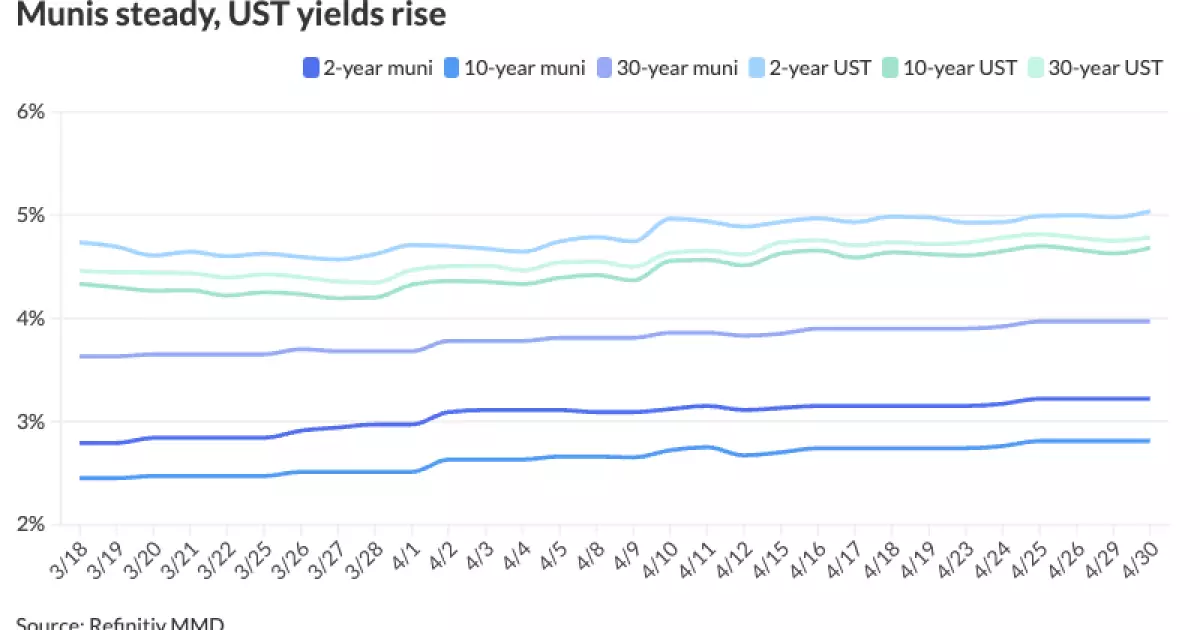The municipal bond market showed little movement in secondary trading on Tuesday as the primary market gained attention with a plethora of deals. This included a $1.9 billion Novant healthcare revenue bond deal in the negotiated market and a general obligation sale from Delaware. Despite the stability in the municipal market, U.S. Treasuries witnessed weakness, and equities experienced a sell-off. The shifts in municipal bond yields were influenced by various factors, including supply and demand dynamics.
Current Yield Trends
Yields on municipal bonds have been on the rise over the past few weeks due to an increase in issuance. This trend has been characterized by higher supply, which, according to Matt Fabian, a partner at Municipal Market Analytics, has led to a strong year-to-date performance for tax-exempts. The 10-year MMD yield has climbed 35 basis points since March 1, with longer yields hovering around 4%. The prevailing levels, combined with spreads, have started to attract retail buyers back into the market.
The surge in municipal bond issuance has presented investors with opportunities to capitalize on the market. Fabian noted that there was around $5 billion in customer net buying activity last Wednesday through Friday, indicating a positive response from the investor community. This heightened issuance activity has not only provided market participants with avenues for investment but has also influenced trading patterns in both the primary and secondary markets.
In the primary market, several notable deals were priced, including the Novant healthcare revenue bond deal, consolidated bonds from the Port Authority of New York and New Jersey, and revenue financing system bonds for the Texas A&M University System. These offerings showcased variations in yields, maturities, and call features, reflecting the diverse nature of municipal bond offerings to cater to different investor preferences.
Market Stabilization Expectations
As the new-issuance pipeline begins to subside, industry experts like Anders S. Persson and Daniel J. Close from Nuveen anticipate that the muni market will stabilize. They highlighted the upcoming coupon reinvestment dates, projecting significant reinvestment income opportunities for investors. The expected inflow of funds into the market could help mitigate some of the volatility seen in recent weeks and provide a stabilizing effect on yields and prices.
Future Market Outlook
Looking ahead, market participants are closely monitoring various factors that could influence municipal bond performance. Fabian highlighted that while fund NAV returns, especially in high yield strategies, have faced challenges in recent weeks, the market could see renewed interest if certain events transpire. Factors such as changes in the corporate tax rate, Federal Open Market Committee (FOMC) decisions, and labor market data releases could impact investor sentiment and trading activity in the municipal bond market.
The impact of supply and demand dynamics on the municipal bond market is evident in the recent trends in issuance, yields, and investor behavior. As the market continues to navigate changing conditions, including increased supply and shifting investor preferences, industry experts are closely monitoring developments to assess the market’s direction. By analyzing these factors and their impact on the market, stakeholders can make informed decisions and adapt to the evolving landscape of the municipal bond market.

